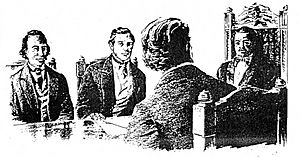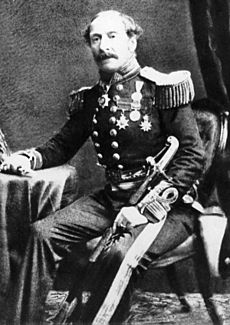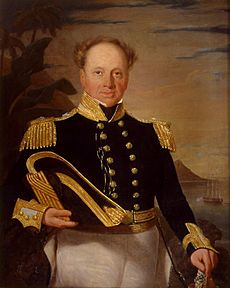Paulet affair facts for kids
Quick facts for kids
Provisional Cession of the
Hawaiian or Sandwich Islands |
|||||||||
|---|---|---|---|---|---|---|---|---|---|
| 25 February – 31 July 1843 | |||||||||

Location of the Hawaiian islands.
|
|||||||||
| Status | Unrecognized and unapproved dependency of Great Britain | ||||||||
| Capital | Honolulu | ||||||||
| Common languages | English, Hawaiian | ||||||||
| Government | Military occupation, British colony | ||||||||
| Monarch | |||||||||
|
• 1843
|
Queen Victoria | ||||||||
| Local Representative | |||||||||
|
• 1843
|
George Paulet | ||||||||
|
• 1843
|
Richard Thomas | ||||||||
| Historical era | International relations | ||||||||
|
• Established
|
25 February 1843 | ||||||||
|
• Disestablished
|
31 July 1843 | ||||||||
|
|||||||||
The Paulet affair was a short, unofficial takeover of the Hawaiian Islands by a British naval officer in 1843. It lasted for five months. Captain Lord George Paulet of the British ship HMS Carysfort led this occupation.
The British government in London did not approve of Paulet's actions. The occupation ended when American warships arrived to support Hawaii's independence.
Contents
British Takeover of Hawaii
In late 1842, Captain Paulet met Richard Charlton. Charlton was the British consul in the Kingdom of Hawaii. A consul is an official who protects the interests of their country's citizens abroad.
Charlton told Paulet that British citizens in Hawaii were not being treated fairly. He also claimed that some land disputes were not being handled correctly. Paulet asked his superior, Rear-Admiral Richard Darton Thomas, for permission to investigate these claims.
Paulet's Demands to the King
Paulet arrived in Honolulu on February 11, 1843. He asked to meet with King Kamehameha III. The King was on another island and would take several days to arrive.
Paulet sent another letter on February 16. This letter was more demanding. He insisted on a private meeting with the King and a proper interpreter.
The King replied that Gerrit P. Judd, his chief government minister, could handle any written messages. Paulet refused to speak with Judd. He had been told by Charlton that Judd was acting like a "dictator." Paulet then listed his specific demands.
Threat of Attack
On February 17, Paulet warned Captain Long of an American ship, USS Boston. Paulet said his ship, HMS Carysfort, would attack Honolulu the next day at 4 PM. This would happen if his demands to the King were not met.
The American ship Boston did not get involved.

Hawaii Gives In Under Protest
On February 18, the Hawaiian government agreed to Paulet's demands. However, they did so under protest. They hoped that a diplomatic group already in London could resolve the issues.
From February 20 to 23, meetings were held between Paulet, Alexander Simpson (acting consul), and the King. King Kamehameha III agreed to look at the disputed cases again. But he refused to ignore the legal process.
On February 25, an agreement was signed. It gave control of the land to Paulet, but only until a diplomatic solution was found. Paulet then set up a commission to act as the new government. He took direct control of all land deals.
Paulet ordered all Hawaiian flags to be destroyed. He then raised the British Union Flag. This marked the start of the six-month occupation. He also removed 156 people from the disputed Charlton land.
American and British Intervention
The Hawaiian government secretly asked for help. Gerrit P. Judd gave James F. B. Marshall, an American merchant, a special mission. Marshall was sent to London to ask for Hawaii's independence.
Paulet had stopped all shipping. But he wanted to send Alexander Simpson back to England to tell his side of the story first. Marshall managed to get on the same ship as Simpson. He told Paulet he was just on a business trip.
Diplomacy in London
Marshall arrived in London on June 30. He met with Edward Everett, the American ambassador. Two other Hawaiian envoys, William Richards and Timothy Haʻalilo, were already in Paris. They were working on treaties and had been told that Hawaii's independence would be respected.
On April 1, 1843, Lord Aberdeen, the British foreign minister, confirmed this. He told the Hawaiian group that the British government would recognize Hawaii's independence.
Admiral Thomas Arrives
American warships began to arrive in Hawaii. The USS Constellation arrived in early July. Its commander, Commodore Lawrence Kearny, heard about the takeover.
Then, on July 22, American Commodore Thomas ap Catesby Jones arrived with the USS United States. He consulted with an American missionary in Hilo.
Admiral Thomas, Paulet's superior, heard about these events. He sailed into Honolulu harbor on his flagship, HMS Dublin, on July 26. He asked to meet with the King. King Kamehameha was happy to tell his side of the story.
Restoration of Hawaiian Sovereignty
On July 31, with American warships present, Admiral Thomas announced that the occupation was over. He said he would protect British citizens but also respect Hawaii's independence.
A ceremony was held to raise the flag of Hawaii again. The place where this happened is now a park in downtown Honolulu called Thomas Square. Its pathways are shaped like the British flag.
July 31 is now celebrated as Lā Hoʻihoʻi Ea, or Restoration Day. A famous quote from King Kamehameha III's speech that day became Hawaii's motto: Ua Mau ke Ea o ka ʻĀina i ka Pono. This means "The sovereignty of the land is perpetuated in righteousness."




